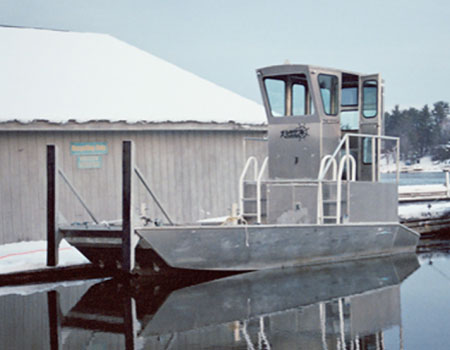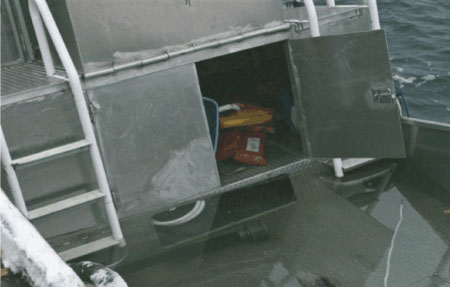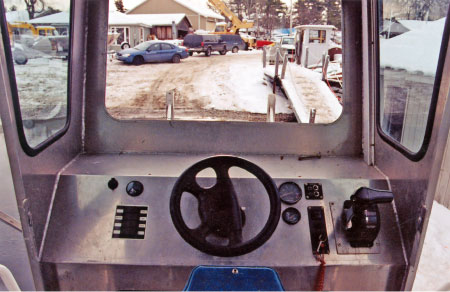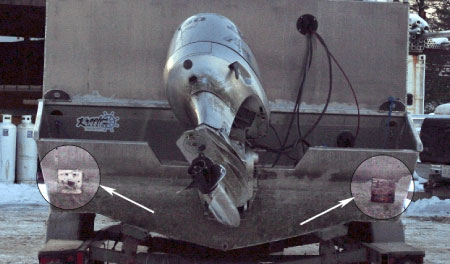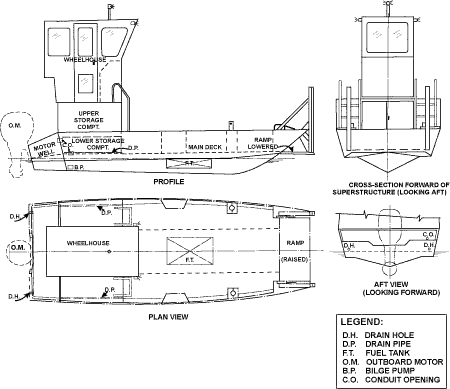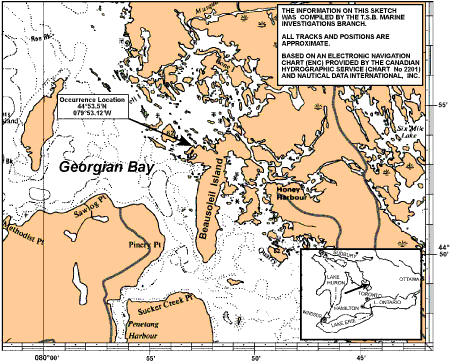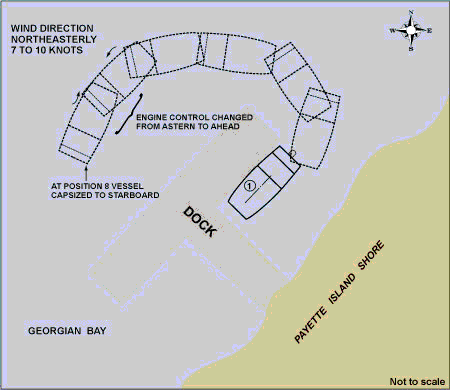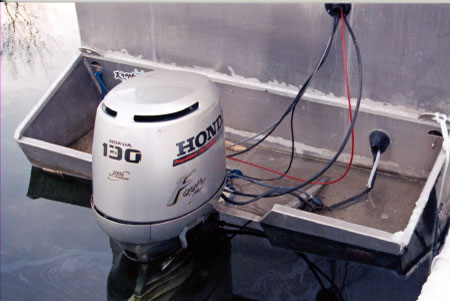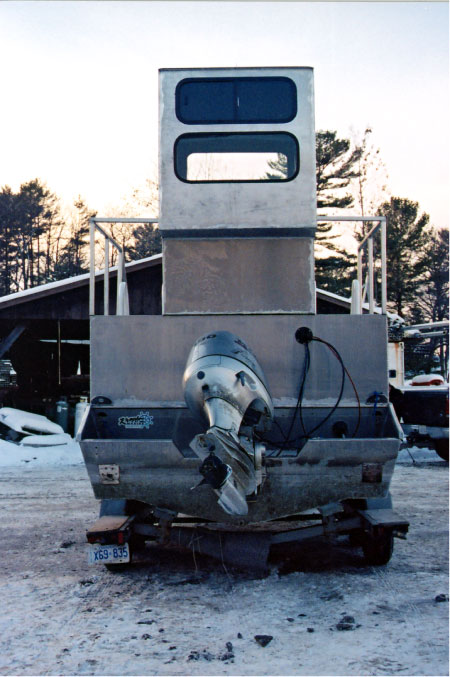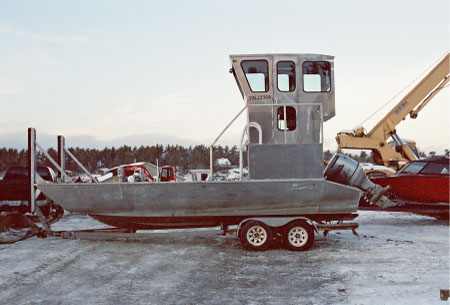Capsizing
Workboat 59E22354
Payette Island, Southeast Georgian Bay, Ontario
The Transportation Safety Board of Canada (TSB) investigated this occurrence for the purpose of advancing transportation safety. It is not the function of the Board to assign fault or determine civil or criminal liability. This report is not created for use in the context of legal, disciplinary or other proceedings. See Ownership and use of content. Masculine pronouns and position titles may be used to signify all genders to comply with the Canadian Transportation Accident Investigation and Safety Board Act (S.C. 1989, c. 3).
Summary
On 10 December 2004, at approximately 1435 eastern standard time, while departing from a work site on Payette Island, Georgian Bay, Ontario, a workboat with four persons aboard capsized. Three persons were rescued, and one person drowned.
Factual information
Particulars of the vessel
| Name | Workboat "59E22354" |
|---|---|
| Registry/licence number | 59E22354 |
| Type | Workboat/Pushboat |
| Gross tonnage | 4.6 (estimated) |
| LengthFootnote 1 | 6.81 m |
| Draught | Forward: 0.30 m Aft: 0.61 m |
| Built | 2000, Kropf Industrial Inc., Parry Sound, Ontario |
| Propulsion | 1 Honda gas-driven outboard motor, 97 kW |
| Cargo | 113.6 kg (estimated) |
| Crew | 2 |
| Passengers | 2 |
| Registered owner(s) | A & A Services and Marine Contracting Limited, Honey Harbour, Ontario |
Description of the vessel
The workboat was constructed of aluminum and originally had a partially enclosed steering station located aft. A hinged ramp was fitted at the bow, which also incorporated two vertical push knees (or fenders), one on each side, for pushing barges. The below-deck side compartments were filled with closed cell foam to provide non-permeable inherent buoyancy, while the centre compartments formed void spaces.
During construction, the following changes were made to the original design:
- the length was increased from 6.095 m to 6.81 m; and
- a four-stroke engine, weighing approximately 225 kg, replaced the two-stroke engine.
In 2002, the vessel's owner made the following additional modifications to the vessel's structure:
- The partially enclosed steering station was converted into a fully enclosed wheelhouse.
- The wheelhouse height was raised by 1.25 m above the main deck (see Photo 1). This allowed the creation of a lower storage compartment, with a height of 0.41 m and a sill of 3.5 cm, and an upper storage compartment of a height of 0.84 m (see Photo 2).
- The wheelhouse was hinged at its forward end so that it could be laid down when the vessel was stored ashore.
- A steering control panel with basic instrumentation, controls for engine operation and a toggle switch to operate the bilge pump were located in the wheelhouse (see Photo 3).
- The wheelhouse was designed to accommodate two persons, with a seat for the operator and a small shelf space behind it, where one other person could sit.
- Access to either side of the wheelhouse was by way of ladders from the main deck.
Forward of the wheelhouse, the gunwale on the main deck was 0.52 m in height. A 1.9 cm diameter hole, port and starboard, in the forward superstructure bulkhead, with pipes leading through the lower storage compartment and terminating at the motor well, provided drainage from the main deck. The sloped deck in the motor well permitted water to drain overboard through two drain holes in the transom. These holes were covered by fastened pieces of plywood. Subsequently, a hole was drilled through the plywood on the port side in way of the drain hole (see Photo 4, which shows that the drain holes were below the waterline indicated by the scum line).
The original "Pulsecraft" designed (20-foot) vessel had a conformity plate and hull identification number; however, at the time of the occurrence, the plate could not be found.
Description of the voyage
At 0930 eastern standard timeFootnote 2 on 10 December 2004, an operator, a crew member and two passengers (trade persons) boarded the workboat with tools and materials at A & A Services and Marine Contracting Limited's dock located in Honey Harbour, Ontario (see Figure 2).
A small barge was connected to the bow of the workboatFootnote 3 as per its normal operating configuration. Their destination was a work site on the north shore of Payette Island, part of the larger Beausoleil Island, southeastern Georgian Bay. The weather was overcast and visibility was good, but inclement weather was forecast for later in the afternoon. The voyage to Payette Island was uneventful and took approximately 45 minutes. The trade persons, tools and materials were landed ashore at the work site. Arrangements were made to retrieve the trade persons in the early afternoon, if the weather deteriorated. The workboat disconnected from the barge and returned to Honey Harbour.
In the early afternoon, the air temperature dropped and heavy snow began to fall. At approximately 1400, the workboat returned in a "planing" mode to pick up the trade persons and berthed on the inboard side of the "T" shaped main dock (see Figure 3).
Tools and equipment were were loaded and stowed mainly in the vessel's upper storage compartment, while some equipment was loaded on deck. Upon departure from the berth, the crew member and the trade persons huddled together with the operator in the wheelhouse for warmth.
The departure manoeuvre was as follows:
- first, the workboat went astern 15 m in a northeasterly direction,
- then the workboat went astern around the end of the dock in a westerly direction for 15 to 20 m,
- finally, the workboat went astern in a southwesterly direction for approximately 15 m, leaving the workboat parallel to the outer face of the main dock.
The operator reportedly engaged the engine control to the "slow ahead" position. The vessel inclined to starboard, and suddenly, at approximately 1435, while within 8 to 10 m of the dock, the port bow lifted and the workboat rapidly capsized to starboard.
The vessel capsized in position 44°53.5′ N and 079°53.12′ W in 5.5 m of water. Nobody was wearing a lifejacket. The cramped space within the wheelhouse made it difficult for persons to escape through either the starboard or port wheelhouse doors. Upon exiting the wheelhouse, some persons managed to shed their work boots and two persons swam to the dock. One person climbed onto the overturned hull and remained there until the vessel drifted closer to shore. He was then helped to shore. The crew member struggled briefly, but then slipped beneath the surface of the water within 1.5 m of the dock. It took approximately three minutes from the time of the capsizing for the three survivors to arrive ashore. They entered a nearby cottage and used a telephone to call 911.
Search and rescue
The 911 operator notified the Ontario Provincial Police (OPP) at Orillia, Ontario, who in turn notified the Joint Rescue Coordination Centre in Trenton, Ontario. Search and rescue (SAR) units were dispatched and a Cormorant aircraft was tasked and later stood down. The 911 operator also notified the owner of the workboat and asked him to provide directions for the ambulance and police. The owner indicated that the site was inaccessible by car but that he would provide assistance with the use of company equipment and personnel. The barge foreman of the company and an assistant, who were working on a nearby island, were dispatched by the owner to the accident location where, with the help of the survivors, they searched for the missing crew member. Within 20 minutes of the 911 call, the survivors were picked up; they were then taken to Honey Harbour and were transported by ambulance to hospital. All were released several hours later.
Ontario Provincial Police search and recovery dive team
Initial efforts to find the body of the crew member were futile due to darkness and heavy snowfall. On 11 December 2004, the OPP Search and Recovery Dive Team returned to the occurrence site. The body of the crew member, wearing his work boots, was found beneath the dock, in the vicinity of the occurrence site.
Vessel condition and recovery
The capsized vessel drifted southwest some 300 m parallel to the shore and came to rest on the bottom. Examination of the vessel indicated that the engine control throttle lever was set to the "full ahead" position and one personal flotation device (PFD) was found in the wheelhouse. When the vessel was brought to the surface in the upright position and examined, the void space below the main deck was full of water. The lower storage compartment was missing its cover; reportedly, it had been removed sometime before this voyage.
The following safety equipment was retrieved from the upper storage compartment:
- 3 PFDs of various makes (total of 4 aboard, 1 was located in the wheelhouse);
- 2 lifebuoys, one 610 mm and one 762 mm in diameter;
- 1 buoyant heaving line and throw bag;
- 1 five-pound dry chemical (DC) fire extinguisher;
- 1 manual bilge pump;
- 1 electric horn; and
- 1 set of navigation lights (two sidelights, one all around light).
Reportedly, flares were stowed in the upper storage compartment and a flashlight and first-aid kit were in the wheelhouse. None of these items were recovered after the capsizing.
The electrically powered main bilge pump was located aft beneath the main deck within the void compartment along the centreline. There was no float switch to automatically start the pump when the water level reached a pre-set depth nor was there a means to determine the amount of water in the compartment. The bilge pump switch was found to be in the OFF position. The bilge pump had been operated routinely earlier that day to clear accumulated water. There were no baffle plates in the centreline-oriented fuel tank, and other than transverse floors, there were no baffles in the void space below the main deck.
Weather conditions
The weather forecast by Environment Canada matched the prevailing weather for the area on 10 December 2004. Snow was forecast; however, the snow flurries came a little earlier than expected during the afternoon. At the time of the occurrence, the weather had deteriorated to heavy snow flurries with winds northeast 7 to 10 knots in sheltered waters. The water temperature was 4°C and the air temperature was 0°C.
Communication
The vessel was not fitted with a very high frequency (VHF) radio or an electronic position-indicating radio beacon (EPIRB) nor were they required by regulations. Cellular telephones were the only means of communication. Contact between the office and the vessel was maintained throughout each working day at pre-set "checking in" and "work-site departure" times. On the day of the occurrence, there was no communication between the vessel and the base before departing Payette Island for the final return trip.
Stability
No stability calculations were carried out for the vessel before or after structural modifications. In its normal working configuration, the vessel coupled to the barge renders the combined unit more stable.
The structural modifications to the vessel in 2002 adversely affected the vessel's stability as follows:
- the added weight of aluminum and glass to the superstructure immersed the vessel deeper into the water, reducing the freeboard and increasing the trim aft;
- the superstructure raised the vessel's vertical centre of gravity (VCG), thereby reducing the metacentric height (GM) of the vessel; and
- the modification to the wheelhouse increased the surface area of the upper works and raised its centre of area, making the vessel more susceptible to heeling in wind.
Following the occurrence, the TSB carried out a simulation of the loaded condition of the vessel following an inclining experiment. Four persons of equivalent weight were positioned in the wheelhouse and equivalent weights, in lieu of the equipment, were positioned in the upper storage compartment and on deck. While in a static condition alongside the dock, the vessel's stern progressively sank deeper into the water. Water flowed into the motor well (see Photo 5) via the port side drain hole and onto the main deck through the drain pipes. Subsequently, water flowed over the motor cut-out in the transom, and was about to flood the lower storage compartment. At that point, the simulation was terminated for safety reasons. Further stability calculations were deemed unnecessary.
Personnel certification
The operator had more than 20 years of experience working with motorboats/workboats. Neither he nor the crew member held a marine certificate of competency or had training in Marine Emergency Duties (MED).
According to the Crewing Regulations, masters of passenger vessels that have a gross tonnage less than or equal to five are not required to hold a certificate of competency.Footnote 4 Before completing six months' cumulative sea time, every crew member must obtain a Marine Emergency Duties certificate in basic safety at a recognized institution.Footnote 5 MED training covers emergency response to first aid, fire, and abandon-ship situations. The owner, operator, and crew member were not aware of this requirement.
Under the 2003 Small Vessel Monitoring and Inspection Program (SVMIP),Footnote 6 crew members are required to demonstrate the necessary level of competency to safely operate a vessel. Transport Canada (TC) inspectors are required to assess the ability of crews to respond correctly in distress situations. For a person in charge of a vessel of this type and size, inspectors will ask questions related to safety, emergency, and survival procedures, and may require a test voyage.
The owner and crew were not aware of MED or other such requirements because there had only been preliminary communications with TC that did not address the full scope of the safety requirements under the regulations or the SVMIP.
Inspection and certification of the vessel
At the time of construction, the manufacturer marked the vessel with a hull identification number and a conformity plate.Footnote 7 The requirement for a licence number applied to small commercial vessels (SCVs) and pleasure craft.
Since the fall of 2004, TC has embarked on a program of identifying small vessels used for commercial purposes and replacing the alphanumeric licensing with a licence starting with the letter "C" indicating commercial usage (that is, 12D34567 to C123456).
From the time of delivery, the vessel was operated by the owner as a commercial vessel. As its gross tonnage was less than 5 and it was carrying less than 12 passengers, the vessel was exempt from annual inspectionsFootnote 8 by TC. However, TC has the mandate to conduct first inspections under the Canada Shipping Act (CSA).Footnote 9
The SVMIP in place at the time of the occurrence contained requirements for licensing or registration, safety (including stability, loading, lifesaving equipment and crewing), and random inspection(s) with respect to SCVs until such time as the appropriate regulations were amended as necessary.
The owner of the workboat did not request the first inspection of his vessel under the CSA and the SVMIP. There were preliminary communications on the subject, but there was insufficient information exchanged and the owner was not aware of the need to do so. No inspection was carried out by TC.
Lifesaving appliances and passenger safety briefing
Since 01 May 2002, the Small Vessel Regulations require passenger safety briefings to be made on small passenger vessels. No formal passenger safety briefing was carried out before departure from Honey Harbour. Reportedly, the operator had pointed out the location of the PFDs to the passengers but neither the crew nor the passengers wore PFDs.
The owner had supplied his employees with anti-exposure/floater work suits for use in cold weather; however, none were aboard on the day of the occurrence.
Company's safety initiative
Safety meetings were conducted every Friday morning, at which time verbal health and safety instructions were communicated. These meetings included, among others, the subjects of safe boating and the carriage of sufficient lifejackets/PFDs. The operator and crew member attended the safety meeting on the morning of the day of the occurrence.
Prior occurrences
Before this occurrence, there were no reported accidents or incidents with this vessel. However, the issues related to operator training on small vessels, the need to have appropriate communication equipment to alert authorities during emergencies, and the need for thermal protection have been identified in another occurrence involving the Ocean ThunderFootnote 10. In that occurrence, the Board expressed concern that the lack of a thermal protection requirement places mariners and passengers, who may find themselves in the water, at undue risk from hypothermia.
On 03 December 2001, a small commercial workboat carrying five construction workers on Lac-des- Deux-Montagnes, Quebec, was swamped and sank, causing three fatalities. The vessel had not been identified as a commercial vessel or inspected by TC, nor had the owner requested the inspection. Investigation by the Quebec provincial Commission de la santé et de la sécurité du travail (Occupational Health and Safety Board) revealed that:
- the workboat lacked reserve buoyancy;
- the available rescue boat was not suitably equipped;
- the cold water conditions contributed to the fatalities; and
- the passengers were not wearing lifejackets.
On 15 May 2002, the workboat 36E33460Footnote 11 was used to transport four roofers and a cargo of used shingles from a construction site on Anstruther Lake, Ontario. In mid-lake, the deeply laden vessel began taking water over the bow. Shortly thereafter, the vessel swamped and sank. The four roofers swam to shore; the operator drowned. Investigation by the TSB revealed that:
- neither Ontario nor federal regulations have provisions to protect workers against hypothermia when travelling as passengers on SCVs;
- in the absence of effective federal and provincial regulatory regime, construction workers travelling as passengers on SCVs may be put at undue risk;
- as a result of an inadequate safety briefing before departure, the roofers did not make use of all the available flotation devices, such as those stored in the plastic bin; and
- TC was unaware that the vessel was operating as a small passenger vessel and no inspection was carried out.
Awareness and communication
In July 2004, an initiative was taken by the local SCV industry to arrange a meeting at Honey Harbour, and all commercial operators/contractors in the area were invited to discuss regulations and safety issues. The meeting was to be chaired by the OPP but was cancelled because a TC representative could not attend. The meeting was re-scheduled to a later date, in the fall. However, many of the contractors originally scheduled for the first meeting were not advised of the subsequent meeting, including the owner of the occurrence vessel.
Analysis
Flooding and capsizing
The structural modifications made to the workboat in 2002 decreased its inherent transverse stability characteristics (see Photo 6 and Photo 7).
In a lightship condition, the freeboard at the aft end in way of the drain hole was minimal and the workboat had an initial trim by the stern. The trim was further increased by the loaded condition of the boat at the time of the occurrence.
In this condition, the drain hole on the port side was submerged. When the vessel went astern, the motor well flooded rapidly and submerged the lower part of the transom.
Water then flowed onto the main deck forward of the superstructure via the drain pipes, accumulating on the deck until the sill height was reached, and flooded the lower storage compartment. The non-watertight conduit opening in that compartment permitted water to downflood into the centre compartment beneath the main deck. The bilge pump in the centre compartment was fitted with a manual switch only and the operator had no way of knowing the amount of water in the compartment.
The vessel's trim by the stern was increased and the waterplane area was reduced until the vessel lost all positive stability and capsized due to the cumulative effect of:
- weights of persons and equipment added above the main deck and towards the aft end of the workboat, and
- the weight and the free surface effects of liquids including the water on deck and flooded compartment.
Lifesaving equipment
Considering the size of the vessel, the PFDs were stowed in the upper storage compartment, in a location readily accessible to passengers and crew. However, the sudden capsizing precluded access to the PFDs.
As demonstrated in this occurrence, emergency situations for small vessels develop rapidly. Good seamanship practices suggest that consideration be given to wearing personal lifesaving equipment during transit, especially during inclement weather.
Cold water immersion
The greatest effects of cold water immersion occur below 15°C. Often, the first shock of exposure to cold water causes heart palpitations and takes the breath away. Within a few minutes, the hands will not be able to grasp or hang onto anything. Water at 4°C, as in this occurrence, makes swimming even more difficult or near impossible because breathing and muscles are severely affected.
After the capsizing, the distance to shore was a few metres. However, as a result of the low water temperature, the crew member, who was reported to be in good health and to be a good swimmer, experienced cold shock and lost the ability to stay afloat unaided, or swim to shore.
Alerting authorities in emergency
The only means of communication on board was by cellular telephone. After the cellular telephone became submerged, it became inoperative. Although it was off-season, the survivors were able to find a serviceable telephone. The vessel was neither equipped with VHF nor an EPIRB, nor were they required. In the absence of an effective means of communication to alert authorities in an emergency or distress situations, valuable time is lost in initiating rescue effort. Timely response of SAR is critical.
Safety awareness
The owner, aware of the danger of hypothermia and drowning during cold climatic conditions, purchased floater suits for his workers. However, an informal safety approach permitted unsafe practices to go undetected, as demonstrated by this occurrence. Despite the forecast of cold temperatures and inclement weather, the floater suits were not carried by the crew.
Additionally, the risks associated with operating the vessel in inclement weather were not fully appreciated; this fact is depicted in neither the crew nor the passengers donning personal lifesaving equipment.
Small commercial vessel safety
Under the previous licensing regime, there was no distinction made between licences issued to commercial vessels and pleasure craft. As such, commercial vessels could not be readily identified. Under the new regime, commercial vessels are licensed separately. There are an estimated 50 000 SCVs operating in Canada.Footnote 12 As of May 2007, TC has indicated that 31 053 SCVs were registered, and that 9020 were licensed.
Small vessels such as the workboat, having a gross tonnage of less than 5 and carrying less than 12 passengers, are not required to be periodically inspected by TC. The regulatory regime uses the principle of a self-enforcement mechanism as a means to ensure compliance. TC, as a regulator, does not have a regime in place to ensure that the self-enforcement mechanism meets its intended objective.
Owners engaged in commercial activity are not necessarily knowledgeable of the marine sector operational requirements. Consequently, an effective compliance monitoring regime ought to include the following elements:
- Identification of Vessels at Risk: Given the large number of small vessels engaged in commercial activity, they should be readily identifiable for
- a targeted approach using a risk profile, and
- dissemination of safety information.
- Ease of Understanding: The regulations ought to be presented in a manner that is readily understood by those to whom they apply.
In this instance, the vessel was not licensed as a SCV, did not undergo first inspection and was not inspected subsequent to the major modification. Additionally, the owner had little to no information regarding the regulatory regime and preliminary communications between TC and the owner regarding SVMIP requirements and other safety issues were ineffective. Furthermore, the postponed/poorly attended meetings to give to the stakeholders and agencies the opportunity to discuss regulations and safety issues indicate that communication between TC and the local industry was less than adequate.
TC has initiated some measures to further safety of SCVs including the publication of a Small Commercial Vessel Safety Guide (TP 14070E), which provides safety-related information for the operation of SCVs.Footnote 13 In addition to the guide being available through its regional offices, it is forwarded to new owners along with the SCV licence.
Identification of vessels is an essential element and primary to the application of a monitoring regime. There are some 10 000 vessels still to be identified. Until such time as the identification process has been completed, some SCVs will continue to be at increased risk.
It is recognized that the use of partnering arrangements is one of the means to further safety, especially in areas of multiple jurisdictions and/or SCV operations. Additionally, provincial governments have a responsibility to ensure that construction site activities are safe, including the use of SCVs. In Quebec, since 1998, a partnering arrangement with TC has been used effectively by linking the province's business licensing system with vessel safety inspection requirements and an additional provincial requirement for vessel insurance. In doing so, SCV activities have been afforded a minimum level of safety.
Findings
Findings as to causes and contributing factors
- The increased centre of gravity of the modified vessel, when combined with free surface effects of liquids, increased the probability of the vessel losing transverse stability and capsizing.
- The workboat capsized when the combined weight of the persons in the wheelhouse (which further raised the centre of gravity) and equipment on board allowed water to be shipped on board through the drain holes and over the transom.
- The bilge pump was not provided with a float-activated switch, nor was there a means for the operator to determine the amount of water accumulated in below-deck compartments.
- The owner of the small commercial vessel did not contact Transport Canada (TC) for a post-modification inspection, nor was he aware of the need to do so.
- Despite inclement weather, the personal flotation devices aboard were not worn and the available floater suits were not carried.
Findings as to risk
- The absence of thermal protection drastically reduces the chances of survival of persons who are in cold water, irrespective of their health condition.
- The absence of an effective means of communicating distress hampers timely rescue response, jeopardizing lives of passengers and crew.
- Ineffective communication between TC and the local industry may result in small vessel owners being unaware of important safety and regulatory measures.
- TC had not identified the workboat as a small commercial vessel. The past system of licensing vessels was not conducive to readily identifying vessels engaged in a commercial operation.
Safety action
Safety action taken
Transport Canada
On 22 December 2004, the TSB issued Marine Safety Information (MSI) 10/04 to Transport Canada (TC) relating to the vessel description, the result of the simulated loading condition and the lifesaving equipment that was recovered from the vessel. The TSB also pointed out that it was unknown how many such vessels were in service, nor how many had been modified after purchase.
The response indicated that:
- TC continues to be proactive in looking for contraventions of the Canada Shipping Act.
- TC is not aware of any similar "modified" vessels; however, several similar "production" hulls do exist.
TC inspected the owner's remaining eight vessels; two of these vessels were detained. Following repairs, the vessels were re-inspected by TC.
Owner/operator
Subsequent to the accident, the operating company has taken the following safety action:
- purchased very high frequency (VHF) radios for all the vessels in the fleet and 14 employees were trained and certified in VHF radio communication with digital selective calling (DSC);
- provided Marine Emergency Duties (MED) A3 training to 23 employees and subcontractors;
- provided a Small Commercial Vessel Operator Proficiency Course and 11 employee were certified;
- employees and subcontractors were certified in basic first-aid training and in advanced first aid;
- 3 employees were certified in the transportation of dangerous goods;
- 18 employees obtained their Pleasure Craft Operator card; and
- established a formal health and safety committee that has developed safety policies and procedures, including requirements to wear floater suits, filing a sail plan, and pre-departure checks of communication equipment.
Safety concern
Of an estimated 50 000 small commercial vessels operating in Canada, TC advises that 31 053 are registered and 9020 are licensed as of May 2007. There are, therefore, some 10 000 yet to be identified.
Although TC has initiated measures to further the safety of these vessels, the Board is concerned that, until all small commercial vessels are properly identified, safety information is disseminated, and owners/operators have an understanding of the applicable regulations, these vessels and their crews will continue to be at risk.
This report concludes the Transportation Safety Board's investigation into this occurrence. Consequently, the Board authorized the release of this report on .
